
Jeans are more than just a secret staple they often become part of our nature, characterized by their irregularity and elasticity. But even the strongest denim isn’t protected from the wear and tear of time. When that unavoidable hole appears, it can feel like the end of the road for your favoured pair. Fear not, though, because as it turns out, sewing a hole in your jeans can breathe new life into them and even add a touch of your personal style. Whether you’re a sewing learner, this final guide will take you through ten different skills to sew up a hole in jeans. Let’s dive in and learn how to sew a hole in jeans like a pro.
1. Patching from Under and Machine Sewing
This is the go-to method for a reason: it’s sturdy and relatively simple. Start by turning your jeans inside out and placing a fabric patch beneath the hole. Use a sewing machine to stitch a square or zig-zag pattern over the affected area. This technique not only reinforces the hole but can also add a subtle decorative element, especially if you use conflicting thread.

Pro Tip: Use a denim needle for your sewing machine to enter the fabric easily.
2. Hand Sewing a Straight Tear
For smaller holes or tears, hand sew a hole in jeans can be the most effective method. Use a basic running stitch to weave in and out of the denim, creating a solid mend. If the hole is worn, consider folding the edges inward to prevent further unravelling before you start stitching.
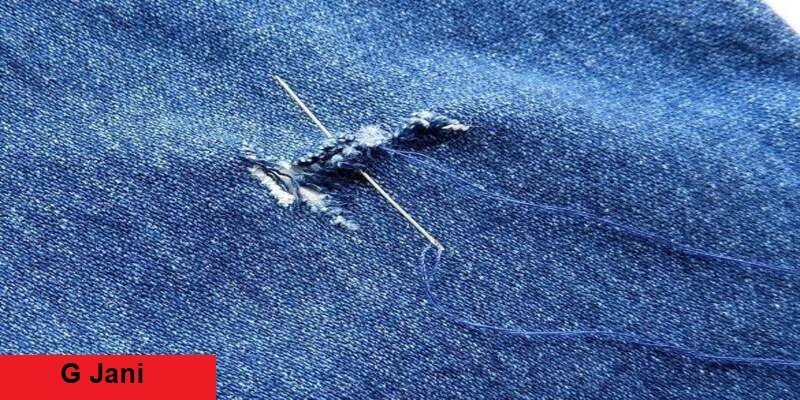
Pro Tip: Choose a thread colour that closely matches your jeans for a close invisible patch.
3. Attaching Store-Bought Patches
When time is of the essence, or the hole is in a noticeable place, store-bought iron-on patches are a speedy fix. Simply cut the patch to size, position it over the hole on the outside of the jeans, and iron it on according to the product instructions. The result is a tough and uniform wash of colour where the hole used to be.

Pro Tip: For additional safety, run a line of machine stitching around the edge of the patch after you have ironed it on.
4. Make Embroidery Stitches over the Hole
Elevate the art of denim mending by using embroidery to cover the hole. Choose a design or pattern you love and use a simple backstitch to outline and fill in the affected area. Embroidery doesn’t just cover the hole it can also add a trendy touch to your jeans.
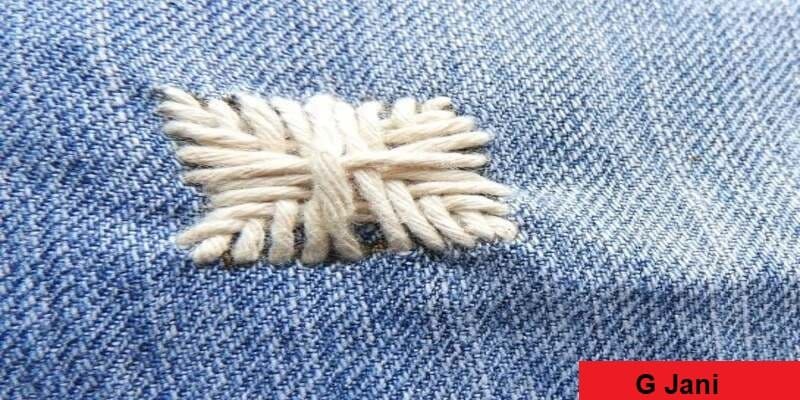
Pro Tip: Consider using multiple shades of thread to create a gradient effect for a more intricate look.
5. Attach Decorative Clothing Patches
Sometimes, a hole presents an opportunity to personalize your jeans. Sew on decorative patches that you love, whether they’re pop culture references, band logos, or just fun designs. This method not only fixes the hole but also introduces a unique element to your denim.
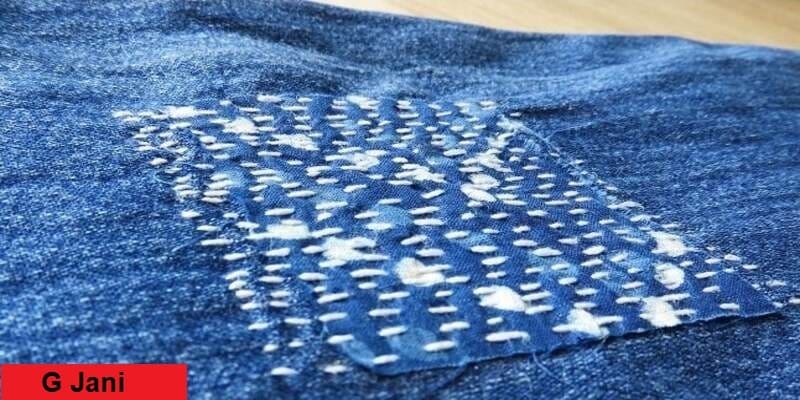
Pro Tip: Mix and match different patches for a collage effect.
6. Do Embroidery After Patching from the Back
Similar to method four, but with a twist. Begin by patching the hole from the inside of the jeans. Then, use embroidery from the outside to further secure the patch and add a design as an extra layer of strength and style.
Pro Tip: This approach is perfect for covering larger holes, as the initial patching will stabilize the area for more detailed embroidery.
7. Sashiko Stitches on Patches
Sashiko, a traditional form of Japanese reinforcement stitching, is making a comeback in modern fashion. After applying the patch, use Sashiko-style stitching to create beautiful geometric patterns. The running stitches not only look great but also create a durable fix for your denim.
Pro Tip: Stick to Sashiko’s traditional indigo and white colour scheme for an authentic touch.
8. Make Darning Stitches to Cover the Hole
Darning is an ancient technique that involves weaving new threads into the existing fabric to repair holes. This is best suited for smaller holes and involves delicate, intricate work. The result is a seamless mend that’s as strong as the original fabric.
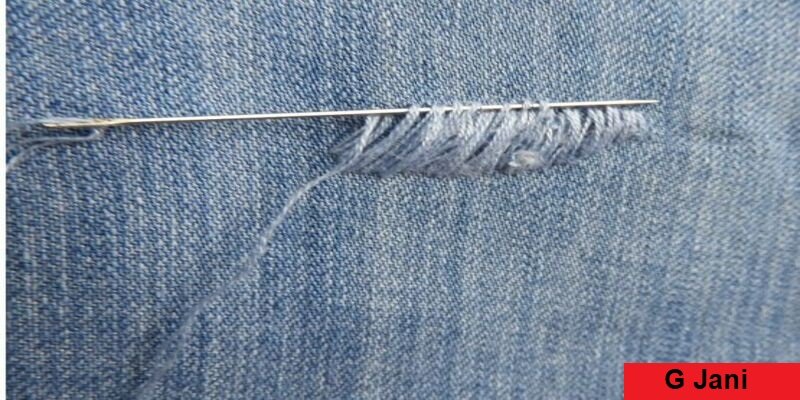
Pro Tip: Use a darning mushroom to maintain tension and prevent distortion of the fabric.
9. Patch with Decorative Fabrics
Finding a fun fabric that contrasts or complements your jeans is an excellent way to make a statement with your repair. Simply cut out a piece of the fabric slightly larger than the hole, and use one of the previous methods to attach it to the inside of the jeans. From there, style the edges however you like, from a simple straight stitch to the more complex Sashiko stitching.
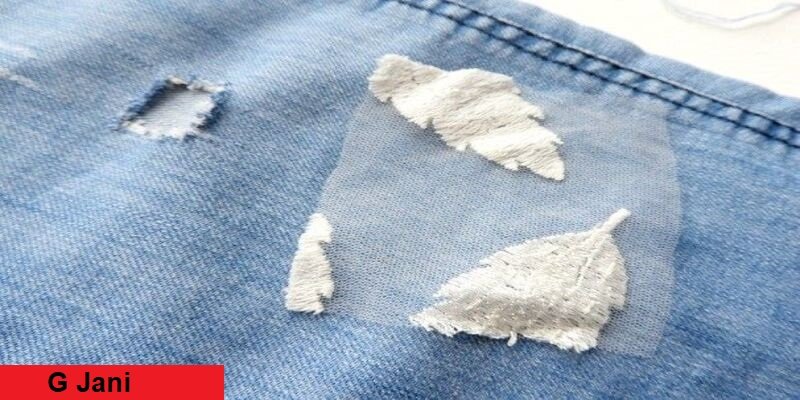
Pro Tip: Pre-wash the new fabric to prevent any shrinking that could cause an uneven hemline.
10. Cut Off the Portion and Attach Another Fabric Overall
For the most fashion-forward fix, consider using a hole in your jeans as an opportunity to upcycle. Cut open the area around the hole and sew in a piece of entirely new fabric. This approach works well on the thigh area or knee, where it’s more about the look than uniformity, and it allows you to add a pop of colour or texture.
Pro Tip: Be sure to cut away a good portion around the hole to ensure the new fabric piece has sufficient room to be securely sewn in place.
Once you have selected the method that suits your style and the nature of the hole, take your time and enjoy the process. Stitching your jeans can be a thoughtful and creative act, rewarding you with a reimagined wardrobe staple and the satisfaction of a job well done. Remember, a well-loved pair of jeans with a history of patches is often the most cherished, worn as a badge of resourcefulness and personality. Sew a Hole in a Shirt can breathe new life into it and even add a touch of your personal style.
FAQs: How to Sew a Hole in jeans: Step-by-step
What materials do I need for sewing a hole in jeans?
You will need a needle, thread, scissors, a patch (optional), and an iron (optional).
Can I use any type of thread?
It is recommended to use a strong and durable thread such as denim thread or polyester thread.
How do I choose the right size needle?
The type and size of needle you need will depend on the weight of your jeans. For heavier-weight denim, use a thicker needle such as a 16/100 or 18/110. For lighter-weight denim, a smaller needle like a 10/70 or 12/80 will work better.
Do I need to prewash the patch before sewing it on?
It is recommended to wash and dry the patch before sewing it onto your jeans. This will help prevent any shrinking or colour bleeding that may occur after washing.
Can I hand-sew a hole in my jeans?
Yes, you can hand sew a hole in your jeans if you do not have access to a sewing machine. Hand sewing may take longer, but it can still produce strong and durable results.

